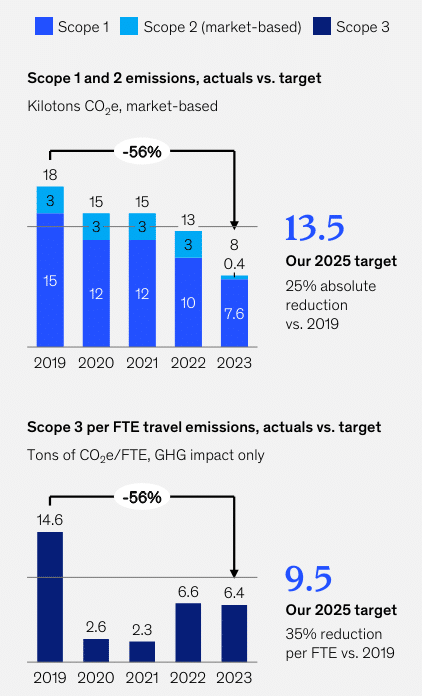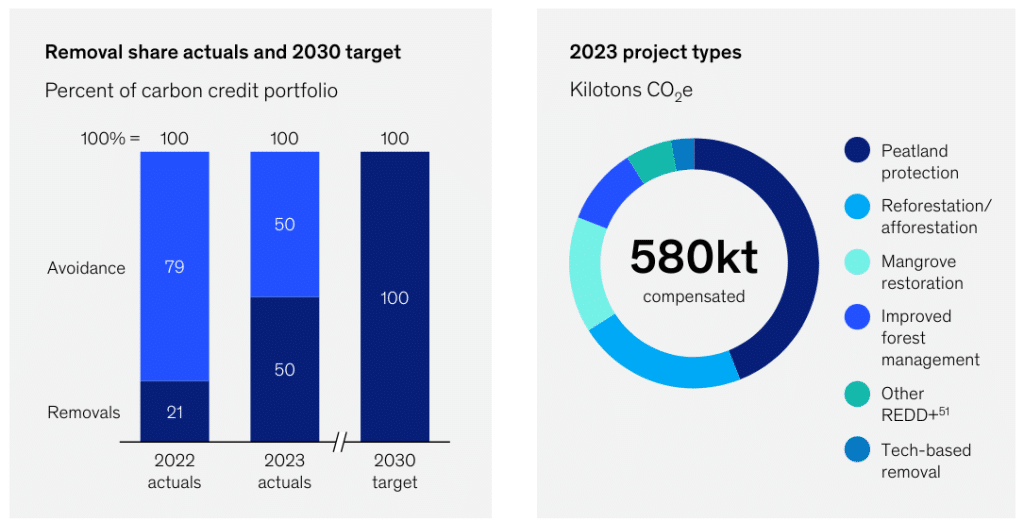McKinsey & Company released its 2023 ESG Report titled “Accelerating sustainable and inclusive growth for all,” detailing its global efforts to promote sustainability and inclusivity. The report highlights McKinsey’s partnerships with clients, colleagues, and communities to foster societal progress.
Here are the key takeaways from McKinsey’s 2023 progress, focusing on their decarbonization efforts.
Unlocking True Value: McKinsey’s Decarbonization Strategy
The net zero transition is transforming the global economy, creating new markets and threatening others. Leaders must reduce emissions, ensure affordable energy and materials, provide reliable energy systems, and enhance competitiveness.
McKinsey has prioritized sustainability, working with clients for over a decade to decarbonize and build climate resilience. The firm is committed to helping all industries reach net zero by 2050 and meet the Paris Agreement goals. McKinsey uses proprietary tools, thought leadership, talent, and cross-sector collaborations to drive innovation and growth.
The firm partners with entrepreneurs and start-ups to scale technological innovations rapidly. It also works with banks and investors to decarbonize portfolios, and engages with high-emission sectors to reduce emissions and costs. By scaling green ventures and expediting decarbonization, organizations can achieve climate commitments quickly, measuring progress in months rather than decades.
McKinsey faces the climate crisis heads-on by charting its path towards net zero with the following progress at a glance:
McKinsey’s Progress Toward Net Zero
Slashing Scope 1 and 2 Emissions
McKinsey has made significant progress towards achieving net zero emissions by addressing Scope 1 and 2 emissions, which account for 2% of their 2019 baseline. In 2023, they reduced absolute Scope 1 and 2 emissions by 56%.
The consulting firm also focused on electrifying their fleet of vehicles, with a remarkable increase in the global use of electric vehicles from 4% in 2019 to 32% by the end of 2023.
The company’s commitment to sustainability extends to making office spaces more sustainable, with 64% of global office space being LEED-certified and 55% being LEED Gold or Platinum certified. Transitioning to renewable electricity has been successful, as McKinsey achieved the goal of sourcing 100% renewable electricity two years ahead of schedule, with 98% procurement aligned with RE100 criteria.
Moreover, McKinsey has conducted comprehensive assessments of water, waste, and biodiversity, taking proactive measures to minimize water consumption and reduce single-use plastics.
Additionally, the firm drives change through local initiatives involving over 1,100 Green Team members. They contribute to reducing the firm’s environmental footprint through various activities like achieving office environmental management system certification, eliminating single-use plastics, and promoting vegetarian options in office cafeterias.
In summary, cutting Scope 1 and 2 emissions results in these major progress:
- Electrifying firm-controlled vehicles: 32% share of EVs
- Making office space more sustainable: 64% LEED‑certifed
buildings - Transitioning to renewable electricity: 100% renewable
- Driving change through local initiatives: 1,100+ Green Team members
Cutting Scope 3 Emissions
Scope 3 emissions primarily originate from air travel, hotels, and ground transportation. In 2023, Scope 3 business travel emissions were down by 56% per FTE against the 2019 baseline. Efforts are underway to partner with suppliers to further reduce Scope 3 emissions.
- Putting a price on emissions:
As of January 1, 2023, McKinsey introduced a global internal carbon fee of $50 per tCO2e on all air travel. The fee is calculated based on flight emissions and will expand to cover all emission categories in 2024.
This fee supports carbon-related procurement, including carbon removals and sustainable aviation fuel (SAF), while also raising colleague awareness of environmental footprints.
- Fostering sustainability in aviation:
Collaborative efforts with airlines, fuel producers, and aviation stakeholders aim to make air travel more sustainable. SAF is deemed crucial, with procurement efforts aimed at building the market and learning from experiences.
Initiatives include participation in SAF RFPs and bilateral SAF certificate purchases, resulting in significant emission reductions. A total of 7,500tCO2e was abated through four SAF offtakes, equivalent to 3% of GHG fight emissions.
With all the decarbonization efforts done and progress achieved by McKinsey, the company managed to reduce its emissions vis-a-vis targets as shown below.
Tackling Residual Emissions with Carbon Credits
Compensating for residual emissions remains a key focus for the multinational consulting company through carbon credits.
Since 2018, they’ve invested in carbon avoidance and removal projects certified by international standards like the Gold Standard and Verified Carbon Standard, alongside Climate, Community & Biodiversity Standards (VCS+CCBS), to offset emissions they can’t yet eliminate.
McKinsey continually assesses its carbon credit project portfolio with third-party due diligence to ensure effectiveness.
In 2023, the company enhanced its approach by diversifying supplier base, refining scoring system based on internal quality criteria, and collaborating with external partners like BeZero, Carbon Direct, and Sylvera for additional feedback.
The sustainability champion also increased its share of carbon removal credits to 50%, primarily investing in nature-based solutions to address climate and biodiversity crises. Additionally, the company made its first technology-based removal purchase to scale biochar technologies.
Ultimately, McKinsey aims to transition to removing 100% of its remaining emissions by 2030. They’ll focus on nature-based solutions and a blended carbon price of around $29/ton.





